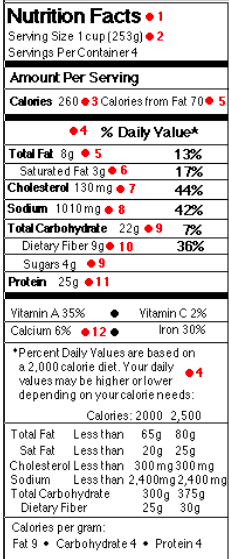 ♦ 1 Title. When you see the title “Nutrition Facts,” you know this is the current information label approved by the Food and Drug Administration.
♦ 1 Title. When you see the title “Nutrition Facts,” you know this is the current information label approved by the Food and Drug Administration.
♦ 2 Serving Size. Is your serving the same size as the one on the label? If you eat double the serving size listed, you need to double the nutrient and calorie values. If you eat one-half the serving size shown here, cut the nutrient and calorie values in half.
♦ 3 Calories. Are you overweight? Cut back a little on calories! Look here to see how a serving of the food adds to your daily total. A 5’4″, 138-lb. active woman needs about 2,200 calories each day. A 5’10”, 174-lb. active man needs about 2,900. How about you?
♦ 4 Daily Value. Feel like you’re drowning in numbers? Let the Daily Value be your guide. Daily Values are listed for people who eat 2,000 or 2,500 calories a day. If you eat more, your personal daily value may be higher than what’s listed on the label. If you eat less, your personal daily value may be lower. For fat, saturated fat, cholesterol and sodium, choose foods with a low % Daily Value. For total carbohydrate, dietary fiber, vitamins and minerals, your daily value goal is to reach 100% of each.
♦ 5 Total Fat. Aim low: Most people need to cut back on fat! Too much fat may contribute to heart disease and cancer. Try to limit your calories from fat. For a healthy heart, choose foods with a big difference between the total number of calories and the number of calories from fat.
♦ 6 Saturated Fat. A new kind of fat? No–saturated fat is part of the total fat in food. It is listed separately because it’s the key player in raising blood cholesterol and your risk of heart disease. Eat less!
♦ 7 Cholesterol. Too much cholesterol — a second cousin to fat — can lead to heart disease. Challenge yourself to eat less than 300 mg each day.
♦ 8 Sodium. You call it “salt,” the label calls it “sodium.” Either way, it may add up to high blood pressure in some people. So, keep your sodium intake low — 2,400 to 3,000 mg or less each day.*
*The AHA recommends no more than 3,000 mg sodium per day for healthy adults.
♦ 9 Total Carbohydrate. When you cut down on fat, you can eat more carbohydrates. Carbohydrates are in foods like bread, potatoes, fruits and vegetables. Choose these often! They give you nutrients and energy.
♦ 10 Dietary Fiber. Grandmother called it “roughage,” but her advice to eat more is still up-to-date! That goes for both soluble and insoluble kinds of dietary fiber. Fruits, vegetables, whole-grain foods, beans and peas are all good sources and can help reduce the risk of heart disease and cancer.
♦ 11 Protein. Most Americans get more protein than they need. Where there is animal protein, there is also fat and cholesterol. Eat small servings of lean meat, fish and poultry. Use skim or low-fat milk, yogurt and cheese. Try vegetable proteins like beans, grains and cereals.
♦ 12 Vitamins & Minerals. Your goal here is 100% of each for the day. Don’t count on one food to do it all. Let a combination of foods add up to a winning score.
Source: University of Iowa Hospitals and Clinics, 200 Hawkins Drive, Iowa City, Iowa 52242
